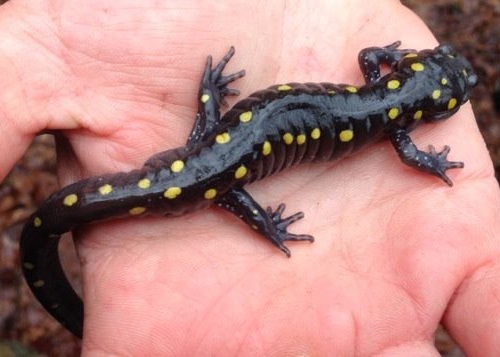Above: One of the early signs of spring is spotting the return of this “voracious predator and gifted swimmer”. (photo contributed by SOLF)
[This post is part of a special guest series focused on appreciating nature in Southborough, contributed by the Southborough Open Land Foundation (SOLF), a non-profit dedicated to preserving and stewarding natural resources here in town.]
As the snow thaws and first warm rain falls, local folks eagerly anticipate the reawakening of watery habitats like ponds and seasonal, vernal pools. The most noticeable signs of early spring, in particular, are the mass return and robust calls and colors of frogs and salamanders, which hibernate in forests nearby. But one of the first to return, as early as the first week of March, is the yellow spotted salamander!
At least 12 different species of amphibians, or vertebrates that thrive both in water and land, have been documented since 2014 in SOLF open spaces, including the Beals Preserve, Bigelow Wildlife Refuge or Templeman Woods, by members and volunteers. Using frog calls, photos and other types of evidence, data from as many as 130 individuals from 5 different species was recorded one morning, when temperature and humidity was just right! Interestingly, according to the Mass Audubon Society, the most abundant vertebrate in the northeast are salamanders, with as many as 1-2 red-backed varieties found on average per square meter of forest. However, to many, the most charismatic and noticeable early birds are the more robust, yellow spotted salamander.
A voracious predator and gifted swimmer, this individual is 20-25 cm long (~9 inches) and more than twice the length and three times the width of its redback cousin, with beautiful, yellow spots every few centimeters from their neck to along their tail. Much of its over 20 year life expectancy is spent hibernating in or under the forest floor, and they are active from mid to late March to breed in vernal pools and attach as many as 100-300 eggs to rocks or sticks. You might consider getting outside with a head lamp as they are nocturnal and, though spotted, can camouflage well in their habitat!
Though timid and unlikely to bite us, they do sneak up on prey well, using teeth and strong jaws to catch a varied diet of insects, spiders, worms and snails. Their hearty bodies and early arrival likely gives them a competitive advantage, as well as secreting a sticky substance that protects them from becoming dinner for skunks, squirrels, turtles or snakes! So, view from a distance and handle with care, since their skin is also very sensitive to dehydration and chemicals like mosquito sprays, sunblock, herbicides and fertilizers, as well as substances used in asphalt, driveway sealants. If you find a salamander in your home, return them outside as they can be quite vulnerable to drying out and unable to return to their natural habitat!
Even with their vulnerability and factors threatening their wellbeing, Southborough residents are helping to protect and support these important creatures. From human, flashlight “crossing brigades” to protect mass, amphibian, breeding pool migration, to using non-toxic approaches when caring for your backyard or even just letting fallen trees or branches rot to provide a home, there are many, easy things we can do to protect salamanders and make your space welcome to our yellow spotted friends!
Have a good photo or sighting of a yellow-spotted salamander ? Let us know!
Want to learn more about SOLF, or volunteer or donate? Check out our site, we’d love to hear from you.
Lawrence Spezzano, Trustee
SOLF – Southborough Open Land Foundation


